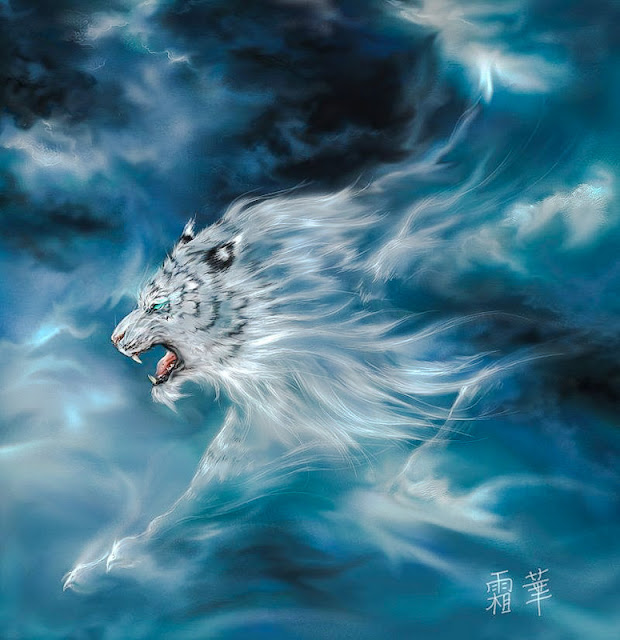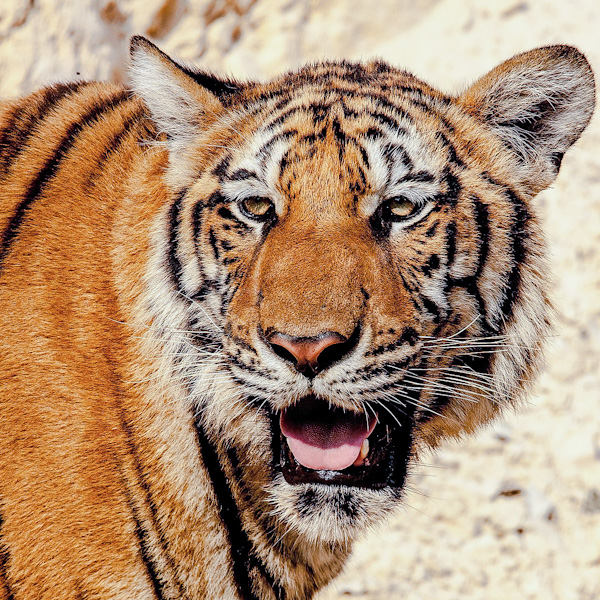Tiger Description
 |
| Tiger |
From a purely descriptive point of view photographs do a better job than words. That said, an overview is appropriate with some links to more. In fact, there are other pages on the subject of tiger description. Please click on the link to see a page on the appearance of the Siberian tiger and on this page there is a large format version of the above montage and a written description. I also have another large page on tiger facts.
The Sunquists say that the tiger is the only striped cat. They mean wild cat because the mackerel tabby (new window) and Togyer (a purebred striped tabby that is meant to look like a tiger) are striped cats. Lots has been said about the weight of the tiger but reliable weights of wildcats are difficult to find7. What is certain is that (a) the tiger is the world's largest cat (excepting man made hybrids such as the Liger) and (b) the weights of the subspecies varies considerably and as you go south the weights are less as the chart below indicates. The smallest tigers are found in the Sunda Islands. In general, the large tigers are found in the Russian Far East and the small tigers in Southeast Asia and Indonesia.
The weight difference between the sexes (dimorphism) increases with latitude being greater in the north. The variation in size is in part due to prey size but there are other factors. Geist's Rule states that the body size of large animals is influenced by "the seasonal amount of food available..to support growth". Another factor is "island dwarfing". Animals on isolated ranges evolve into smaller sizes. Sumatra, Bali and Java are all islands resulting is confined, isolated ranges.
Tigers also follow what is called the Bergmann's Rule. The surface area to body volume ratio of small animals is greater in small animals. This means a greater loss of body heat. The cold climates in the Amur region of Russia dictates that body heat is retained, hence the larger size. Some Bengal tigers are very large but their range extends to the north of India where they can be found at altitudes over 4,000 feet in Bhutan - Tigers of Bhutan.
In Java a smallish deer (sambar deer - is this deer smaller on Java?) was the principle prey of the Javan tiger while Siberian tigers prey on larger animals such as the red deer and moose. The background colour of the tiger varies with latitude too. The Indonesian tigers (Bali - extinct, Java - extinct and Sumatra) were or are darker too7. The fur is also understandably shorter and less dense as the climate is considerably warmer.
Officially the tiger's background color is reddish orange to ocherous7 (the color of ocher; esp., dark yellow15). The underparts and inside of the limbs, throat, chest, muzzle and around and above the eyes are white creating a very high contrast coat. There is the usual white "ocelli" on the back of the ear flap. The tiger has the very recognizable dark vertical stripes on the flanks and shoulders. They vary in width and spacing and each, like a finger print is unique allowing researchers to identify individual tigers from photographic records (see Tiger Patterns and Tiger Stripes). The number of stripes also varies with subspecies. Tigers in south Asia tend to have more stripes averaging about 30 at the flank whereas Siberian tigers average 22.
The Amur (Siberian) tigers and Sumatran tigers can be recognised by the length of their fur. The Amur tiger has the longest fur on the neck, back and belly. The Sumatran has the longest "facial ruff hair"1.
The high contrast and colorful coat looks as if it is poor camouflage but in the dappled forest light and under other typical tiger habitat scenarios it is perfect. Although in Siberia, in the snow, this cannot be the case. It is interesting to see how the coat has become somewhat out of step with the landscape with respect to tigers living in Siberia.
Very rarely, there have been black tigers (melanistic or pseudo-melanistic tigers) and there are certainly white tigers (and see Snow tigers) and blue tigers. These colour variations are all due to genetic mutations and none are considered separate species of tiger. There are three records of black tigers from the Mayanmar/NE India/Bangladesh area. There is no evidence in existence other than the recorded sighting. White tigers are common in captivity and either extremely rare or non-existent in the wild. They are inbred in captivity being the descendants of a single male Bengal tiger cub called Mohan captured in 1951 in Madhya Pradesh, India.
RELATED: Black tiger cub in the wild.
There "is a tendency towards dark well stripped tigers in Southeast Asia and the Sunda Islands" (5). Although there is considerable variation within a subspecies.
A tiger description must mention the athleticism of the tiger. The tiger is very powerful and built to capture and hold on to large prey. Their forelimbs are noticeably more powerful than the hind limbs. They are fine climbers and swimmers. The Siberian and Bengal stand about one meter tall at the shoulder. The tallest domestic cat who at one time was MAGIC, a F1 Savannah cat was 17.1 inches tall at the shoulder. One meter is 39.37 inches. The tiger is taller at the shoulder than at the rear. They are similar in size to the lion but at the end of the day, I say the tiger would win in a Lion vs Tiger fight (which cannot take place as their ranges are very far apart). Many people disagree with me.
There "is a tendency towards dark well stripped tigers in Southeast Asia and the Sunda Islands" (5). Although there is considerable variation within a subspecies.
A tiger description must mention the athleticism of the tiger. The tiger is very powerful and built to capture and hold on to large prey. Their forelimbs are noticeably more powerful than the hind limbs. They are fine climbers and swimmers. The Siberian and Bengal stand about one meter tall at the shoulder. The tallest domestic cat who at one time was MAGIC, a F1 Savannah cat was 17.1 inches tall at the shoulder. One meter is 39.37 inches. The tiger is taller at the shoulder than at the rear. They are similar in size to the lion but at the end of the day, I say the tiger would win in a Lion vs Tiger fight (which cannot take place as their ranges are very far apart). Many people disagree with me.
RELATED: Lion versus Tiger - Lion Wins.
Tiger description -- Notes:
Tiger description -- Notes:
- 3. Feline Conservation Federation magazine vol 53 issue 3 - Robert M Johnson
- 7. Wild Cats Of The World - Sunquists - 2002
- 15. Your Dictionary
- 5. Riding the tiger: tiger conservation in human-dominated landscapes By John Seidensticker
- 1. Great Cats edited by Seidensticker and Lumplin.



